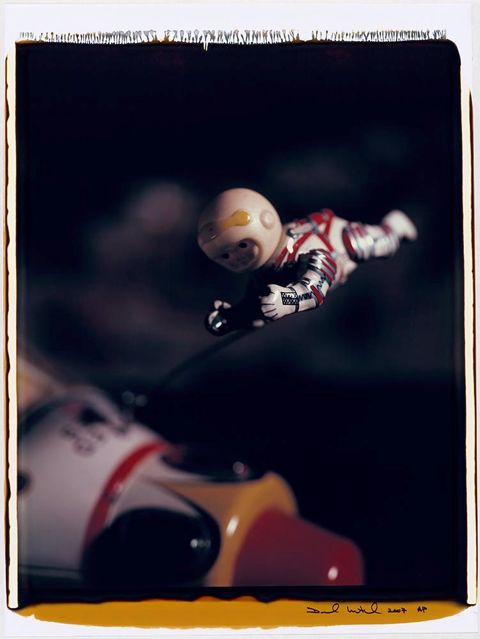“David Levinthal: Photographs 1972–2016” Explores Themes Central to American History, Identity, and Consciousness

David Levinthal, Untitled, from the series Space, 2007, dye diffusion transfer print, the Museum of Fine Arts, Houston, gift of an anonymous donor. © David Levinthal
David Levinthal, Untitled, from the series Wild West, 1994, dye diffusion transfer print, the Museum of Fine Arts, Houston, gift of an anonymous donor. © David Levinthal
Opening October 14, the exhibition celebrates a recent gift of photographs spanning the noted artist’s career to date
HOUSTON—September 27, 2017—Since the early 1970s, New York-based photographer David Levinthal has used staged photographs of toys and other everyday objects to bring viewers face-to-face with themes central to American history, identity, and consciousness. Beginning in October, the Museum of Fine Arts, Houston, celebrates the gift of 44 works by the artist with David Levinthal: Photographs 1972–2016. Donated by Donald Rosenfeld, John A. MacMahon, and an anonymous donor, the photographs will be presented alongside a selection of Levinthal images already held by the Museum, providing a rich overview of the artist’s work. The exhibition will be on view from October 14, 2017, to February 19, 2018.
Through the iconography of mass-produced toys, dolls, and figurines, Levinthal’s photographs have probed the myth of the American West; World War II and the Holocaust; romantic and sexual desire; racial stereotyping; the heroism of sport; and the futuristic fantasy of space exploration. The images range from intimately scaled prints to large 20-by-24-inch Polaroids and monumental inkjet prints. Evoking the visual language of photojournalism, pornography, television, film, and religious art, they elicit a response not to the actual moment or event or object, but to the place it holds in a collective American consciousness. The artist has stated about his Wild West series, for example, that those images depict “the West that never was but will always be.”
“The Museum is enormously grateful to this trio of donors for these generous gifts, which are so essential to supporting the Museum’s holdings of contemporary photography and David Levinthal’s work in particular,” commented MFAH Director Gary Tinterow. “With this gift, we are able to have a significant representation of each of the artist’s major series.”
Added Malcolm Daniel, the Gus and Lyndall Wortham Curator of Photography, “David Levinthal’s photographs tap into the visual and media icons that have shaped America’s collective consciousness. Hovering between the convincingly real and the obviously artificial, Levinthal’s photographs have a seductive beauty that can be unsettlingly at odds with his often-disturbing subject matter.”
The exhibition David Levinthal: Photographs 1972–2016 will feature images from the following series:
- Bad Barbie (1972)
- Hitler Moves East (1972–75)
- Modern Romance (1983–85)
- Wild West (1986–2002)
- American Beauties (1989–90)
- Space (1988–89, 2007)
- Passion (2005)
- Mein Kampf (1993–94)
- Blackface (1995–98)
- Baseball (1998–2004)
- XXX (1999–2001)
- Netsuke (2002)
- Hockey (2007)
About David Levinthal
David Levinthal was born in San Francisco in 1949, and lives and works in New York City. He received a B.A. in studio art from Stanford University, an M.F.A. in photography from Yale University, and an M.S. in Management Science from MIT Sloan School of Management. He is the recipient of fellowships from the National Endowment for the Arts and the John Simon Guggenheim Foundation, and his work is held in major public collections around the world, including the Museum of Fine Arts, Houston, the Menil Collection, The Metropolitan Museum of Art, the Whitney Museum of American Art, and the Museum of Modern Art. To date, he has published 18 photobooks, from Hitler Moves East (1977) to the most recent History (2015).
Organization
This exhibition is organized by the Museum of Fine Arts, Houston.
Generous support is provided by Sanders Morris Harris Group.
About the Museum of Fine Arts, Houston
Established in 1900, the Museum of Fine Arts, Houston, is among the 10 largest art museums in the United States, with an encyclopedic collection of more than 65,000 works dating from antiquity to the present. The main campus comprises the Audrey Jones Beck Building, designed by Rafael Moneo and opened in 2000; the Caroline Wiess Law Building, originally designed by William Ward Watkin, with extensions by Ludwig Mies van der Rohe completed in 1958 and 1974; and the Lillie and Hugh Roy Cullen Sculpture Garden, designed by Isamu Noguchi and opened in 1986. Additional spaces include a repertory cinema, two libraries, public archives, and facilities for conservation and storage. Nearby, two house museums—Bayou Bend Collection and Gardens, and Rienzi—present American and European decorative arts. The MFAH is also home to the Glassell School of Art and its acclaimed Core Residency Program and Junior and Studio Schools; and the International Center for the Arts of the Americas (ICAA), a leading research institute for 20th-century Latin American and Latino art.
About the MFAH Photography Collection
The Museum’s world-renowned photography collection comprises more than 32,000 items spanning the full history of the medium, from invention to present day. Virtually every photographic process is included, from daguerreotypes, albumen prints, and salt prints in the 19th century; to platinum and gum-bichromate prints at the turn of the 20th century; and gelatin silver prints and all manner of color photography in the modern era. Among the collection's great strengths are American photography, with extensive holdings of civil-rights photography, Texas photography, and the Photo League; avant-garde photography between the two World Wars; photojournalism; 19th-century European photography; and Japanese photography. More than 4,000 photographers are represented in the collection. The department displays highlights of the collection on a rotating basis in A History of Photography: Selections from the Museum’s Collection as well as in temporary installations and special exhibitions.
Media Contact
Laine Lieberman, publicist
713.639.7516 / llieberman@mfah.org
